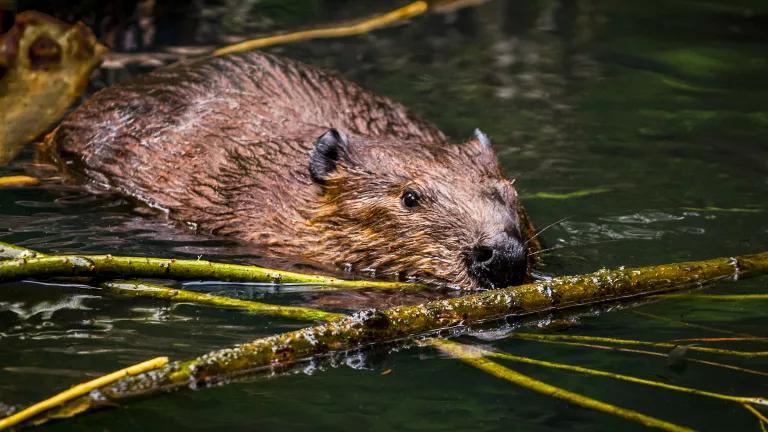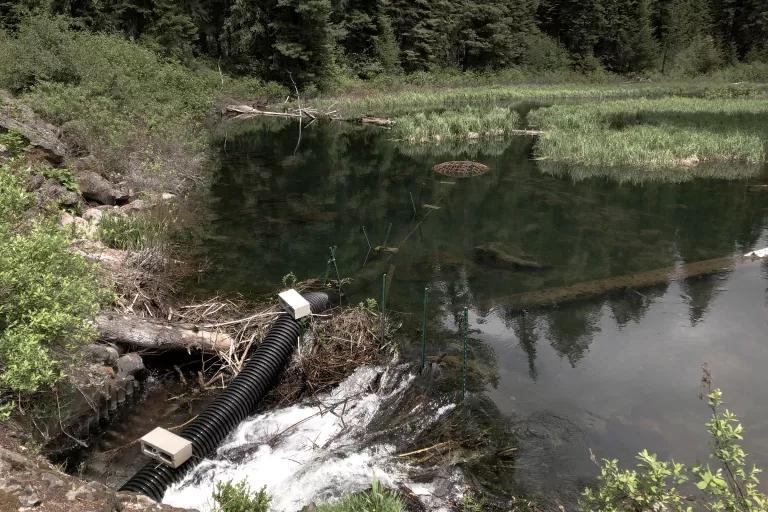The Humble Beaver: Troublemaker or Climate Superhero?
Beavers create rich habitats and act as buffers against the effects of drought and wildfire—spurring efforts to pinpoint new ways to help us coexist with North America’s largest rodent.

A beaver gathering branches
For wildlife enthusiasts trekking the trails at western Montana’s Lost Creek State Park, a glimpse of a mountain goat or bighorn sheep climbing the park’s towering limestone cliffs is a treasured sight. Birders, meanwhile, visit to search for golden eagles soaring overhead or the Clark’s nutcracker flitting among Lost Creek’s Douglas firs. Less often do park goers seek out the humble beaver.
Nevertheless, the four-legged landscape engineer—and inadvertent troublemaker—makes itself known. Take what happened at the park, for instance, last spring. At one point along the road that runs parallel to Lost Creek is a culvert that drains runoff from the mountainous terrain. There, beavers felled nearby aspen and other trees and set about constructing a dam in front of the culvert. With the pipe blocked, the water level behind the dam rose. “They have made these really beautiful ponds on one side of the road,” says beaver expert Elissa Chott. The deep water ensures the entrance tunnels leading to the beaver lodge—built of sticks, mud, and rocks—remain beneath the surface, providing protection from predators. And the large expanse of water offers easy access to the fresh leaves, stems, and bark that the vegetarians consume.
But what the beavers considered as the perfect place to build a home, the land managers at Lost Creek considered a nuisance. The rodents so effectively blocked the culvert that their ponds flooded the road. So the officials called Chott, who heads up the Beaver Conflict Resolution pilot project. A joint partnership formed last year between the Montana-based Clark Fork Coalition, National Wildlife Federation, and Defenders of Wildlife, the project aims to help public and private landowners find nonlethal solutions for dealing with problematic beavers.
Certainly, the animals’ tendencies to damage infrastructure and flood homeowners’ basements is only one way to define their relationship with people. For centuries, the trade in valuable beaver pelts helped spur the exploration and settlement of North America. This trade led to conflict between France and Great Britain, and the downfall of an animal that had once numbered up to an estimated 400 million across the continent. Thanks to significant reintroductions beginning in the mid-1900s (with biologists going to such lengths as parachuting beavers into remote Idaho wilderness), they’re now moving back into much of their historical range. Simultaneously, they’re increasingly coming into conflict with humans.
There are ample reasons for people and North America’s largest rodent to learn to better coexist as these mammals rebound across the West. Beavers manipulate the landscape for their own purposes, but mounting evidence shows that the marshy expanses they create may act as a buffer against drought and wildfire, both of which climate change is exacerbating. Myriad other species benefit from the efforts of the industrious rodents too. Algae and aquatic plants thrive in their ponds and provide nourishment for fish, birds, and mammals. One study found 50 percent more species in beaver-built ponds than in other wetlands in the same area. When the beavers eventually exhaust their woody food supply, they move to a new location—but even then, the ecosystems they’ve engineered continue to give back. Their abandoned dams and ponds leak and drain, in turn giving rise to lush, grassy meadows that draw nesting songbirds and other animals.

Despite the benefits they bring, across the country, it’s legal, with a permit, to trap and kill beavers. Conservationists like Chott are hoping to avoid turning back the clock on the species’ recovery. Beavers do sometimes have to be removed, she says, but in most cases, there are simple tools to take care of the headaches they create for their human neighbors. “I have found that people are willing to have beavers on their property, just as long as they’re not causing damage,” she says.
At Lost Creek, her team removed the dam and enclosed the culvert entrance with fencing, blocking beavers’ access to it. Anticipating that the wily mammals would rebuild the dam against the fence—which they did—they also installed a pipe, or pond leveler, that runs through the culvert fence, with a cage on the upstream side to thwart beavers from plugging the opening. The key, Chott notes, is to allow water to move through the dam without making a leaking sound. That drip drip drip or whoosh of water is what triggers beavers to get busy at patching holes. (Biologist Lars Wilsson investigated the animals’ housekeeping tendencies with a series of experiments in the 1960s, concluding, “They would always build against the sound of running water from a loudspeaker, or water running from a hose on the dam.”) Had the toothy rodents been targeting trees of concern, Chott notes she would have wrapped the trees with fencing.
Jennifer Sherry, a wildlife advocate at NRDC, sees parallels between Chott’s mission and her own work to reduce conflicts between landowners and resurging wolves, bears, and other large carnivore populations. “The management status quo is to react by killing an animal that threatens property or causes damage,” she says. “This perpetuates the conflict because whether you’re removing a wolf or a beaver, new individuals can easily move into the same area and then you’re back where you started. With large carnivores, we’ve seen a lot of success in preventing conflicts through more proactive, nonlethal measures. These opportunities also exist for beavers. It’s an adjustment for people to learn how to live with these animals and to appreciate the benefits that they offer.”
Some of those benefits are still being revealed. Emily Fairfax, an ecohydrologist at California State University Channel Islands, has found that the clever creatures are creating wetlands uniquely resistant to drought and wildland fire. She has mapped an estimated 5,000 dams in California, Idaho, Montana, Nevada, Oregon, Washington, and Wyoming using satellite imagery. Using remote sensing, she compared how a drought or a fire affects the quality of the vegetation in areas with dams versus similar stretches without them. “It’s very clear that beavers keep things green,” she said. In contrast, in the undammed riparian zones she studied, the drought-ravaged landscapes had far less vegetation.
Fairfax is working to find ways to get higher-resolution imagery so she can tease apart what may make beaver-shaped landscapes better able to withstand the effects of climate change. Ultimately, she’d like to devise a tool for land managers to use when considering their resident rodents—an empirical model, perhaps, that would allow them to determine the number of beavers or dams needed to see an appreciable fire- or drought-buffering effect. After all, she notes, many land managers who encounter beavers are already searching for ways to help recharge groundwater and nurture native vegetation. But “because beavers were absent for so long, they don’t understand how the beavers fit into that [work].” As a result, they continue to resort to trapping or removing beavers, she says.
But “what if we could provide a number?” Fairfax asks. “If you could say that having X number of beavers is going to preserve 900 acres of wetlands during fire, and that should hold true for 70 percent of likely fires,” would that change attitudes toward beavers?
Today, thankfully, conservationists no longer need to resort to such extreme measures as dropping beavers from the sky to help their populations recover. Instead, they’re watching the paddle-tailed architects slowly move back into the streams where their ancestors lived, carrying on the compulsion to stop the drip drip drip of gentle water flows, and leaving healthier, more resilient habitats in their wake.
This NRDC.org story is available for online republication by news media outlets or nonprofits under these conditions: The writer(s) must be credited with a byline; you must note prominently that the story was originally published by NRDC.org and link to the original; the story cannot be edited (beyond simple things such as grammar); you can’t resell the story in any form or grant republishing rights to other outlets; you can’t republish our material wholesale or automatically—you need to select stories individually; you can’t republish the photos or graphics on our site without specific permission; you should drop us a note to let us know when you’ve used one of our stories.

Killing Coyotes with Cyanide? There Must Be a Better Way.
The Lower Klamath River Will Soon Flow Freely Again
Missing for a Century, the California Condor Flies Over Yurok Ancestral Lands Again